|
|
|
Sort Order |
|
|
|
Items / Page
|
|
|
|
|
|
|
| Srl | Item |
| 1 |
ID:
171964
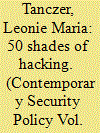

|
|
|
|
|
| Summary/Abstract |
The hacker is the epitome of a cybersecurity threat and the embodied misuse of the Internet. However, in recent years, notions of hacking have begun to change. Blurred boundaries mark the term, best expressed in its overlap with “security researcher.” This article draws on a 3.5-year research project on the hacker community and applies an international political sociology framework to uncover routines of rationalization. Interviews with IT and cybersecurity industry experts expose accepted identities, practices, and behaviors of hackers, which allows for the construction of in-group and out-group members in the IT and cybersecurity field. Additionally, the empirical findings are used to propose a conceptual framework (the Möbius strip) to situate the moral valence of hackers on a flexible model. Thus, the article provides insight into the ontological and normative complexities that define the study of hackers, as well as the perception of IT and cybersecurity professionals.
|
|
|
|
|
|
|
|
|
|
|
|
|
|
|
|
| 2 |
ID:
190422
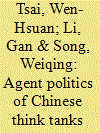

|
|
|
|
|
| Summary/Abstract |
This paper analyzes the relationship between the Chinese government and domestic think tanks. Chinese think tanks in the cultural sector have a strong demand-side orientation; that is, they closely follow the instructions of the Chinese Communist Party (CCP) in their stand on culture-related policies. Since 2018, the CCP has strengthened its control over the propaganda and cultural affairs, using think tanks to this end. Think tanks act as dual agents, maximizing the benefits offered by their two principals – the party government and private businesses, while prioritizing the former. The paper examines the development of the Putuo Island Park in Zhejiang Province and the Cultural Industry Research Institute, the key cultural industry think tank in this province. While upholding Xi Jinping’s aspiration of developing China into a “cultural great power,” cultural think tanks’ main function is to endorse government policies and guide businesses to support those policies when necessary. The CCP under Xi has intensified its manipulation of think tanks to reinforce its control over ideology and the socialist market economy, resulting in a more complex relationship between the state and think tanks.
|
|
|
|
|
|
|
|
|
|
|
|
|
|
|
|
| 3 |
ID:
184545
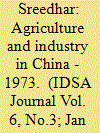

|
|
|
| 4 |
ID:
024795


|
|
|
|
|
| Publication |
Washington, DC, US Government Printing Office, 1970.
|
| Description |
xx, 791p.: ill., mapshbk
|
|
|
|
|
|
|
|
|
|
|
|
Copies: C:1/I:0,R:0,Q:0
Circulation
| Accession# | Call# | Current Location | Status | Policy | Location |
| 005982 | 954.032/SHI 005982 | Main | On Shelf | General | |
|
|
|
|
| 5 |
ID:
140557
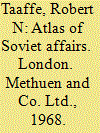

|
|
|
|
|
| Publication |
London, Methuen and co. ltd., 1968.
|
| Description |
x, 143p.pbk
|
| Standard Number |
416948804
|
|
|
|
|
|
|
|
|
|
|
|
Copies: C:1/I:0,R:0,Q:0
Circulation
| Accession# | Call# | Current Location | Status | Policy | Location |
| 001840 | 911.47/TAA 001840 | Main | On Shelf | General | |
|
|
|
|
| 6 |
ID:
109285
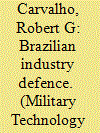

|
|
|
| 7 |
ID:
076350
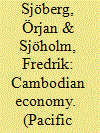

|
|
|
|
|
| Publication |
2006.
|
| Summary/Abstract |
Cambodia is facing the familiar problem of achieving sustained rates of economic growth that could help it alleviate widespread poverty. Against the background of some encouraging developments, and quite a few that are not equally reassuring, we argue that any push for development needs to consider both agriculture and industry. This is so as both labour absorption, primarily in secondary sector activities, and productivity growth in agriculture are necessary to lift large segments of the population out of the poverty associated with subsistence agriculture, landlessness and informal sector activities. Given that the major success story of the past decade - the garment and textile industry - is under threat, we conclude that Cambodia is yet to achieve an economic take-off.
|
|
|
|
|
|
|
|
|
|
|
|
|
|
|
|
| 8 |
ID:
110252
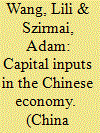

|
|
|
|
|
| Publication |
2012.
|
| Summary/Abstract |
This paper presents new estimates of capital inputs in the Chinese economy. Estimates are made for the total economy (1953-2007), for the industrial sector (1953-2007) and for manufacturing (1985-2007). The capital input estimates for industry and manufacturing are also broken down by thirty regions. The paper makes a systematic attempt to apply SNA (System of National Accounts) concepts to the estimation of capital inputs, according to the Perpetual Inventory Method. It makes a clear distinction between capital services from a productivity perspective and wealth capital stocks. The paper provides a detailed analysis of the relevant Chinese statistical concepts and data. It provides an explanation of the procedures followed in constructing the new national and regional capital input series.
|
|
|
|
|
|
|
|
|
|
|
|
|
|
|
|
| 9 |
ID:
041986
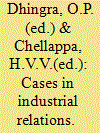

|
|
|
|
|
| Publication |
New Delhi, Shri Ram centre for industrial relations, 1971.
|
| Description |
vi, 144p.Hbk
|
|
|
|
|
|
|
|
|
|
|
|
Copies: C:1/I:0,R:0,Q:0
Circulation
| Accession# | Call# | Current Location | Status | Policy | Location |
| 007680 | 658.3151/DHI 007680 | Main | On Shelf | General | |
|
|
|
|
| 10 |
ID:
106526
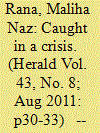

|
|
|
| 11 |
ID:
140137
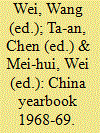

|
|
|
|
|
| Publication |
Taipei, China Publishing Co.,
|
| Description |
832p.hbk
|
|
|
|
|
|
|
|
|
|
|
|
Copies: C:1/I:0,R:0,Q:0
Circulation
| Accession# | Call# | Current Location | Status | Policy | Location |
| 004075 | 951.05/WEI 004075 | Main | On Shelf | General | |
|
|
|
|
| 12 |
ID:
121212
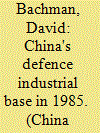

|
|
|
|
|
| Publication |
2013.
|
| Summary/Abstract |
This essay assesses various dimensions of China's defence industrial enterprises. It argues that the defence industrial system should be divided into two tiers: tier one, composed of weapons and equipment producers for the military, and tier two, composed of "civilian" industrial enterprises that provided critical inputs for tier one enterprises, and which in national emergencies could be mobilized to produce weapons themselves. In 1985, there were 1,158 tier one defence enterprises and 827 tier two enterprises among China's 8,285 large- and medium-scale enterprises. Additional information is provided on defence enterprise shares of the economy at the provincial and the national levels, on enterprise distribution by industrial sector, and on when enterprises were built. The article attempts to estimate the total number of workers, output value and fixed assets of the defence industrial sector, and their weight in the national economy.
|
|
|
|
|
|
|
|
|
|
|
|
|
|
|
|
| 13 |
ID:
116740
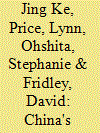

|
|
|
|
|
| Publication |
2012.
|
| Summary/Abstract |
This study analyzes China's industrial energy consumption trends from 1996 to 2010 with a focus on the impact of the Top-1000 Enterprises Energy-Saving Program and the Ten Key Energy-Saving Projects. From 1996 to 2010, China's industrial energy consumption increased by 134%, even as the industrial economic energy intensity decreased by 46%. Decomposition analysis shows that the production effect was the dominant cause of the rapid growth in industrial energy consumption, while the efficiency effect was the major factor slowing the growth of industrial energy consumption. The structural effect had a relatively small and fluctuating influence. Analysis shows the strong association of industrial energy consumption with the growth of China's economy and changing energy policies. An assessment of the Top-1000 Enterprises Energy-Saving Program and the Ten Key Energy-Saving Projects indicates that the economic energy intensity of major energy-intensive industrial sub-sectors, as well as the physical energy intensity of major energy-intensive industrial products, decreased significantly during China's 11th Five Year Plan (FYP) period (2006-2010). This study also shows the importance and challenge of realizing structural change toward less energy-intensive activities in China during the 12th FYP period (2011-2015).
|
|
|
|
|
|
|
|
|
|
|
|
|
|
|
|
| 14 |
ID:
143424
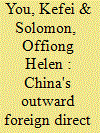

|
|
|
|
|
| Summary/Abstract |
In the past decade, China's outward foreign direct investment (FDI) has increased significantly. On the other hand, the Chinese economic growth model is heavily reliant on domestic investment. Our study examines the important issue of how China's domestic investment responds to its FDI outflows. We investigate this issue analyzing, for the first time, China's domestic investment at industrial level. We specifically account for the factor of government support given the significant role played by the state in the Chinese economy. Using industrial level data, we further evaluate whether domestic investment reacts to outward FDI differently between state dominated and non-state dominated industries. Our study adopts an accelerator model where the system-Generalized Method of Moments (GMM) is employed for our estimations. Our empirical results suggest that domestic investment responds positively to outward FDI in China, Furthermore, the FDI outflows influences domestic investment differently depending on the level of government support in the particular industries. Such influence is much stronger in state dominated industries than in the non-state dominated ones.
|
|
|
|
|
|
|
|
|
|
|
|
|
|
|
|
| 15 |
ID:
095947
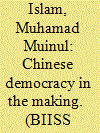

|
|
|
| 16 |
ID:
100351
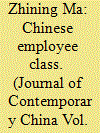

|
|
|
|
|
| Publication |
2010.
|
| Summary/Abstract |
As the 'World's Factory', China now has the biggest worker/employee class in the world. Though this newly emerging social group has captured much attention, relatively few scholars have paid attention to such sociological questions as raised by this paper: rather than referring to such a huge group of almost 500 million people simply as 'Chinese workers' or 'Chinese employees', can this social class be stratified and in what way? What is the current situation of the employee class in China's contemporary industrial relations? This paper attempts to concisely answer the above questions by proposing a three dichotomy segmentation approach and a review of the existing literature on the matter, providing a broader picture to the readers with regards to the current situations of different employee groups in the context of China's unprecedented transitional economy.
|
|
|
|
|
|
|
|
|
|
|
|
|
|
|
|
| 17 |
ID:
120803
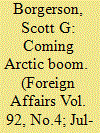

|
|
|
|
|
| Publication |
2013.
|
| Summary/Abstract |
No matter what one thinks should be done about global warming, the fact is, it's happening. And its effects are not all bad. In the Arctic, it is turning an impassible region into an emerging epicenter of industry and trade.
|
|
|
|
|
|
|
|
|
|
|
|
|
|
|
|
| 18 |
ID:
132746
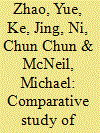

|
|
|
|
|
| Publication |
2014.
|
| Summary/Abstract |
The industrial sector consumes about 50% of the world×s delivered energy and thus has a large impact on the world×s energy production and consumption. Japan is one of the leading countries in industrial efficiency while China is the world×s largest industrial energy consumer. This study analyzes the energy consumption and efficiency of the Japanese and Chinese manufacturing industry. Analysis shows that the energy intensity of both Japanese and Chinese manufacturing industry has decreased significantly. Decomposition analysis shows that the efficiency effect played an important role in reducing energy intensity; improvement of the energy efficiency of both Japanese and Chinese manufacturing industry showed a trend of exponential decay. Structural effect significantly reduced the energy intensity of the Japanese manufacturing industry while having a relatively small influence on the energy intensity of the Chinese manufacturing industry. Our analysis also shows a strong association of industrial energy efficiency improvement with energy policies, highlighting that energy efficiency policies can play an important role in the reduction of industrial energy intensity. The results of this study also underscore the important, yet very challenging, task of achieving structural change to further improve efficiency.
|
|
|
|
|
|
|
|
|
|
|
|
|
|
|
|
| 19 |
ID:
078024
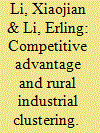

|
|
|
| 20 |
ID:
121333
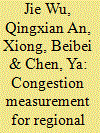

|
|
|
|
|
| Publication |
2013.
|
| Summary/Abstract |
The industry in China has been developing extensively in the last few decades. Large investments in China's industry may cause congestion because congestion is a widely observed economic phenomenon in such a scenario. In order to know the performance and allocate resources well, it is necessary for the Chinese government to measure congestion of the industry. Many scholars have studied this topic by means of data envelopment analysis (DEA). However, previous studies only pay attention to the framework of desirable outputs. In fact, undesirable outputs often accompany desirable outputs in production. Thus, in this study, a new approach for measuring congestion with undesirable outputs is proposed and applied to analyzing congestion of the industry in 31 administrative regions of China. The results show that five regions have congestion in their industry in 2010. Besides, the regions located in the east of the country perform the best in ecological efficiency, followed by regions in central and west China. Based on these findings, this paper proposes some political schemes to improve regional industrial efficiency.
|
|
|
|
|
|
|
|
|
|
|
|
|
|
|
|
|
|
|
|
|